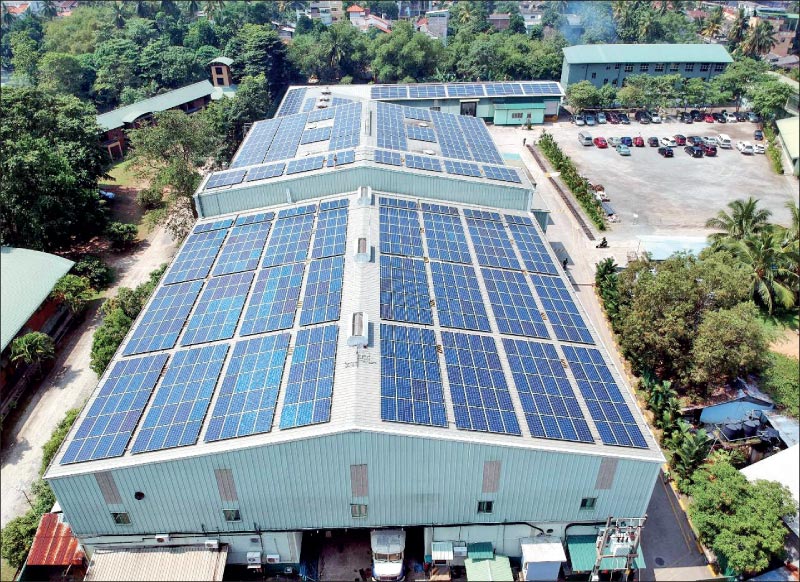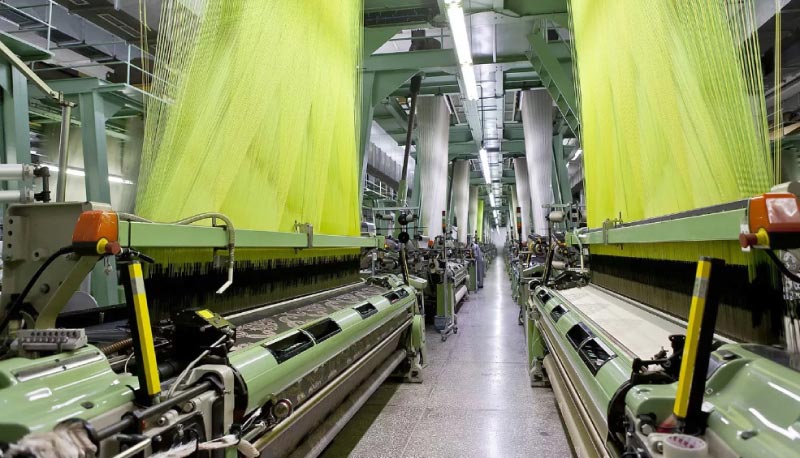Monday Apr 21, 2025
Monday Apr 21, 2025
Monday, 20 May 2024 00:00 - - {{hitsCtrl.values.hits}}
| According to the World Bank, our manufacturing industry was responsible for 25% of Sri Lanka’s greenhouse gas emissions in 2023 |
| Just 6,000 industrial entities account for 93% of the industrial electricity |
| The CEA is now working to change the application process so that companies will be required to provide greenhouse gas-related data |

Some industrial sectors are making changes to adopt renewable technologies

Of the 70,000 industrial entities supplied by the CEB, 350 consume 42% of all industry sector electricity
 To change something, first you have to understand it. But unless you fully understand what you are trying to change, you will be moving forward with your eyes closed. You will be struggling to understand the situation as you will be feeling your surroundings in the dark.
To change something, first you have to understand it. But unless you fully understand what you are trying to change, you will be moving forward with your eyes closed. You will be struggling to understand the situation as you will be feeling your surroundings in the dark.
When it comes to tackling the climate crisis, we know we must step away from fossil fuels to reduce the greenhouse gas emissions that pollute the environment and cause climate change. This is a major challenge for Sri Lanka. We rely on imported fossil fuels to power our country and our economic growth, but fossil fuel use causes trouble on both environmental and economic fronts.
Through our Nationally Determined Contributions, the Sri Lankan Government has identified the sectors that generate the greatest volume of emissions and set sector-specific targets to reduce them. According to the World Bank, our manufacturing industry was a significant emitter, responsible for 25% of Sri Lanka’s greenhouse gas emissions in 2023. This means it is also a significant part of the solution, so much so that the Sri Lankan Government has committed to reducing industrial emissions by 7% by 2030. But to make this change in a way that protects this essential part of our economy, first we need to fully understand what is happening in our industries. And this is where the value of data is exhibited.
The right data, triggering the right decisions
From textiles to tea, rice to rubber, many different industrial sectors contribute to our economic prosperity. Some of these sectors are already making changes to reduce energy waste and adopt renewable technologies: the two main thrusts that can end our reliance on fossil fuels. Making these changes are both environmentally and financially sensible: it is the key to unlocking the energy security we need to avoid any future energy crises. But until recently we have not known sector-specific fuel use, which industrial sectors are contributing most to pollution, and which sectors are further behind in making the changes that are needed.
Getting the right data will shed a new light on the situation. It is only by monitoring what is actually happening in our different industrial sectors that the Sri Lankan Government will be able to make effective decisions on which sectors it needs to focus its efforts on – and where to spend its limited resources.
Not that we are starting from scratch. Data on industrial energy use and emissions is already collected by five government ministries or agencies. But this collection has been ad hoc, and different agencies have been measuring different things. For instance, data on industrial fuel use has been collected, but this has been measured in monetary terms not from the units of volume of fuel consumed, and as fuel costs have fluctuated this has made it difficult to calculate greenhouse gas emissions.
Gathering momentum
Our job is to support the Ministry of Environment, the Ministry of Industry and the Ministry of Power and Energy to fully understand industrial energy use in order to change it. This work is part of a five-year EU-funded program to accelerate Sri Lankan industry’s climate response. We began by requesting and analysing industrial energy use data from the main suppliers in the country. Data sent to us from the Ceylon Electricity Board, the country’s dominant electricity supplier, shows it supplies around 70,000 industrial concerns. Closer inspection reveals that around 350 of these businesses consume 42% of all industry sector electricity. Drilling down further, we can see that just 6,000 industrial entities account for 93% of the industrial electricity. This means the remaining 64,000 industrial businesses – the vast majority – consume only 7% of industry sector electricity.
Having this data helps us understand where to focus to help the biggest consumers of fossil fuel-based electricity change to renewable sources like hydropower. But we are not stopping there. After months of painstaking effort, we now know which industrial sub-sectors these 6,000 businesses belong to. For example, we know there are around 660 garment and textile businesses and they consume 16% of industry sector electricity, and the 700 or so tea factories in this country consume around 5.6%.
This might make you conclude that the textile and garment sector should take priority over tea. But the textile and garment sector is already making a lot of effort to reduce fossil fuel use to remain competitive in the global market, so there is more potential in the tea manufacturing sector or other sectors such as rice processing.
These are what we call ‘lightbulb’ moments, and they are building the momentum we need to make the changes that will have the greatest impact.
Simple data solutions
We now have a more accurate picture than ever before on sector-specific industrial energy use in Sri Lanka, but there is still a long way to go.
For instance, big industrial businesses purchase fossil fuel from the main suppliers. But smaller industrial businesses often purchase oil from roadside fuel stations. These smaller purchases are counted as transport fuel in national statistics, when this fuel is actually being used for manufacturing. A limited survey carried out in 2015 by the Sri Lanka Sustainable Energy Authority found that nearly 5% of transport fuel in western provinces is used for things other than transport. This misreporting can be even larger in agricultural areas.
Another challenge is that we have only established current industrial use and emissions for electricity, liquid petroleum and gas. But biomass – organic matter that can be used to generate thermal energy – is the most widely used fuel source within industry, and we still don’t know the quantity being consumed or the associated emissions. Nor do we have consistent data on how much thermal energy and renewable energy our industries are using. In time, data will shine light on these grey areas as well. We have now found a simple solution to gather some of this missing information without causing industrial businesses extra expense or time. Each year, companies must apply to the Central Environmental Authority (CEA) for an environmental protection licence. The CEA is now working to change the application process so that companies will be required to provide greenhouse gas-related data, such as their annual consumption of electricity, oil, diesel, fuel oil and biomass.
The usage data that companies supply will be verified by the CEA then fed into a central online data system, known as a Measuring, Reporting and Verification (MRV) System, the gold standard of climate-change related data collection. This way, all the government departments and agencies that need it can access the same, consistent data set.
This will enable the Government to know where to allocate resources for things like renewable technology development, tax breaks or training so they have the biggest impact, enabling our industries to grow cleanly, sustainably and without suffering from energy-security issues. And we will be able to make these changes with confidence because we will no longer be deciding in the dark.
The Accelerating Industries’ Climate Response in Sri Lanka is a five-year project which began in 2022, led by the Ministry of Environment, the Ministry of Industry and the Ministry of Power and Energy, implemented by UNIDO and funded by the European Union under the Global Climate Change Alliance+.
(Harsha Wickramasinghe is Deputy Director General at the Sri Lanka Sustainable Energy Authority, and Jagathdeva Vidanagama is Chief Technical Specialist at the United Nations Industrial Development
Organization (UNIDO).)
Discover Kapruka, the leading online shopping platform in Sri Lanka, where you can conveniently send Gifts and Flowers to your loved ones for any event including Valentine ’s Day. Explore a wide range of popular Shopping Categories on Kapruka, including Toys, Groceries, Electronics, Birthday Cakes, Fruits, Chocolates, Flower Bouquets, Clothing, Watches, Lingerie, Gift Sets and Jewellery. Also if you’re interested in selling with Kapruka, Partner Central by Kapruka is the best solution to start with. Moreover, through Kapruka Global Shop, you can also enjoy the convenience of purchasing products from renowned platforms like Amazon and eBay and have them delivered to Sri Lanka.
Discover Kapruka, the leading online shopping platform in Sri Lanka, where you can conveniently send Gifts and Flowers to your loved ones for any event including Valentine ’s Day. Explore a wide range of popular Shopping Categories on Kapruka, including Toys, Groceries, Electronics, Birthday Cakes, Fruits, Chocolates, Flower Bouquets, Clothing, Watches, Lingerie, Gift Sets and Jewellery. Also if you’re interested in selling with Kapruka, Partner Central by Kapruka is the best solution to start with. Moreover, through Kapruka Global Shop, you can also enjoy the convenience of purchasing products from renowned platforms like Amazon and eBay and have them delivered to Sri Lanka.